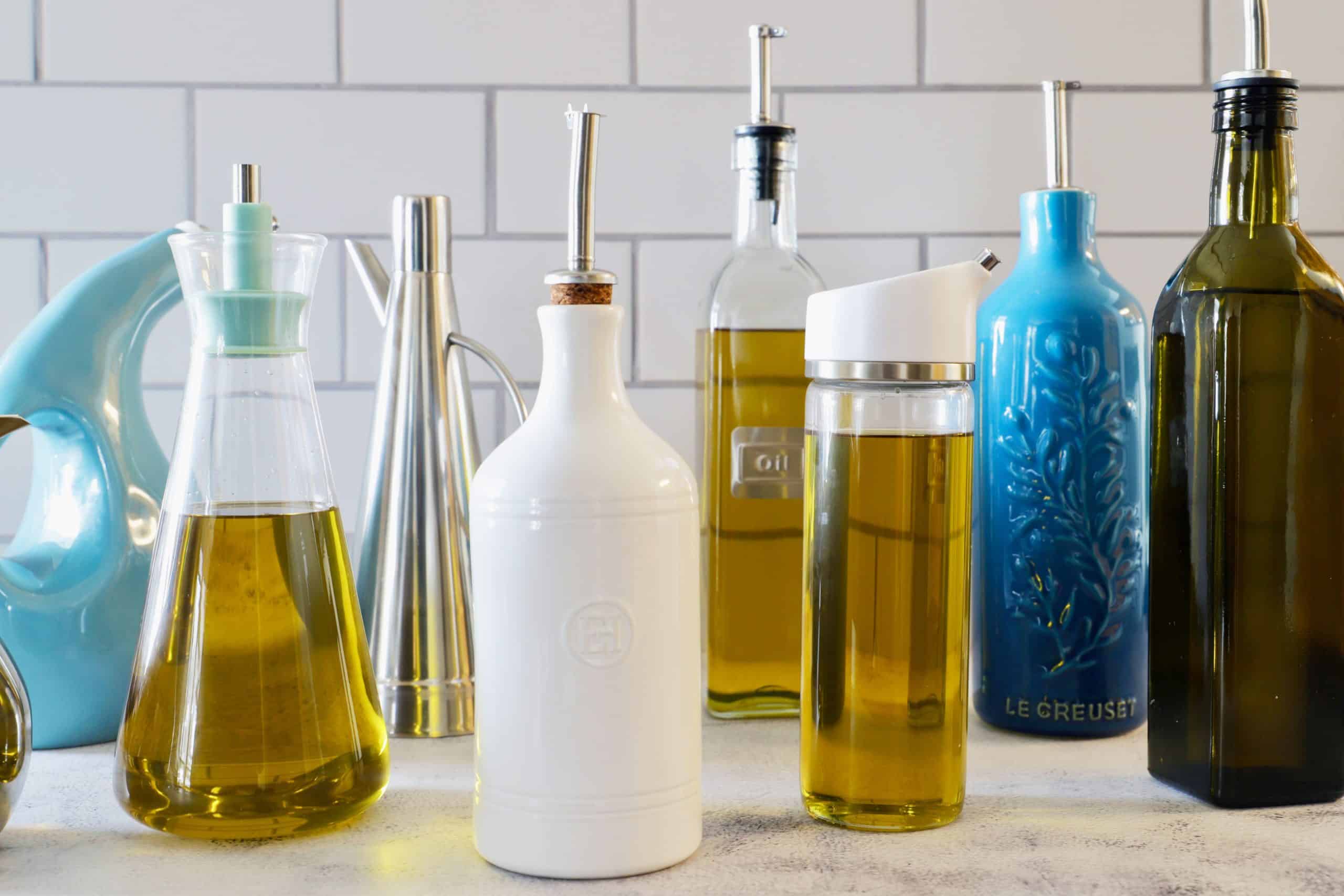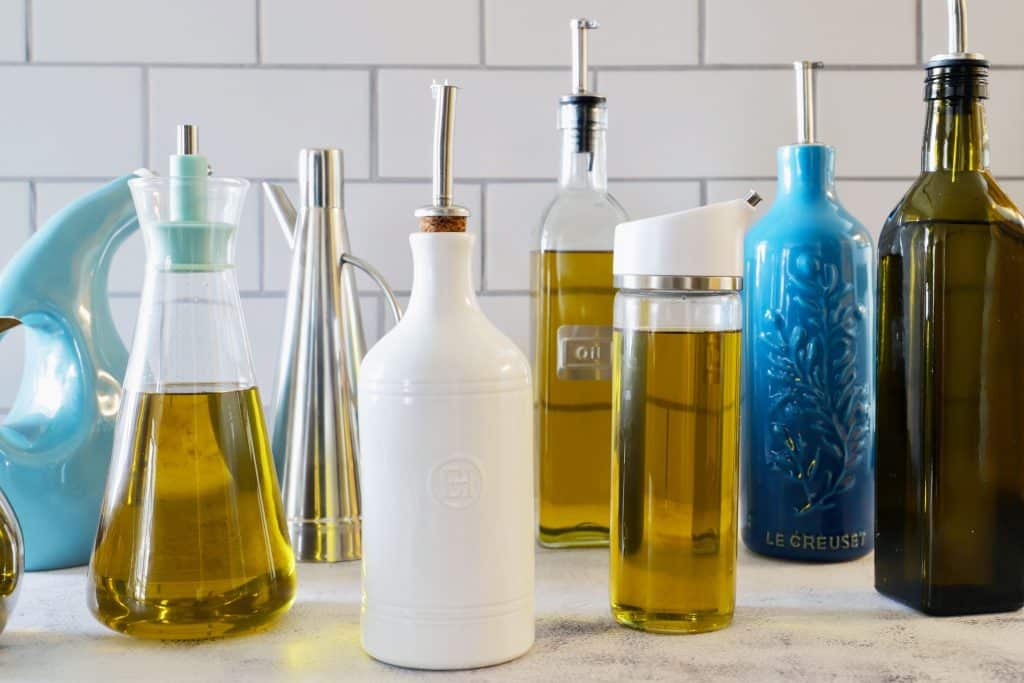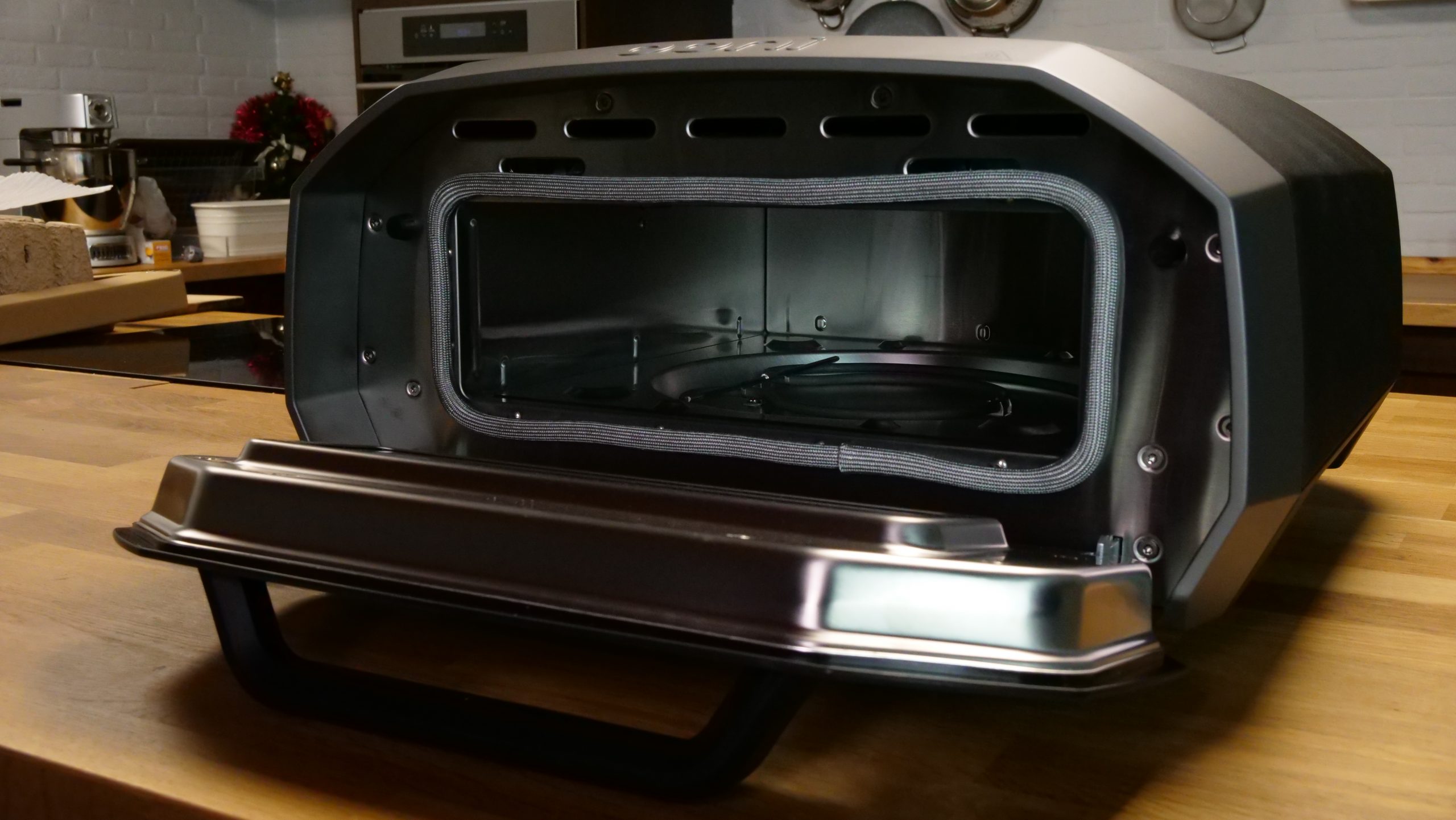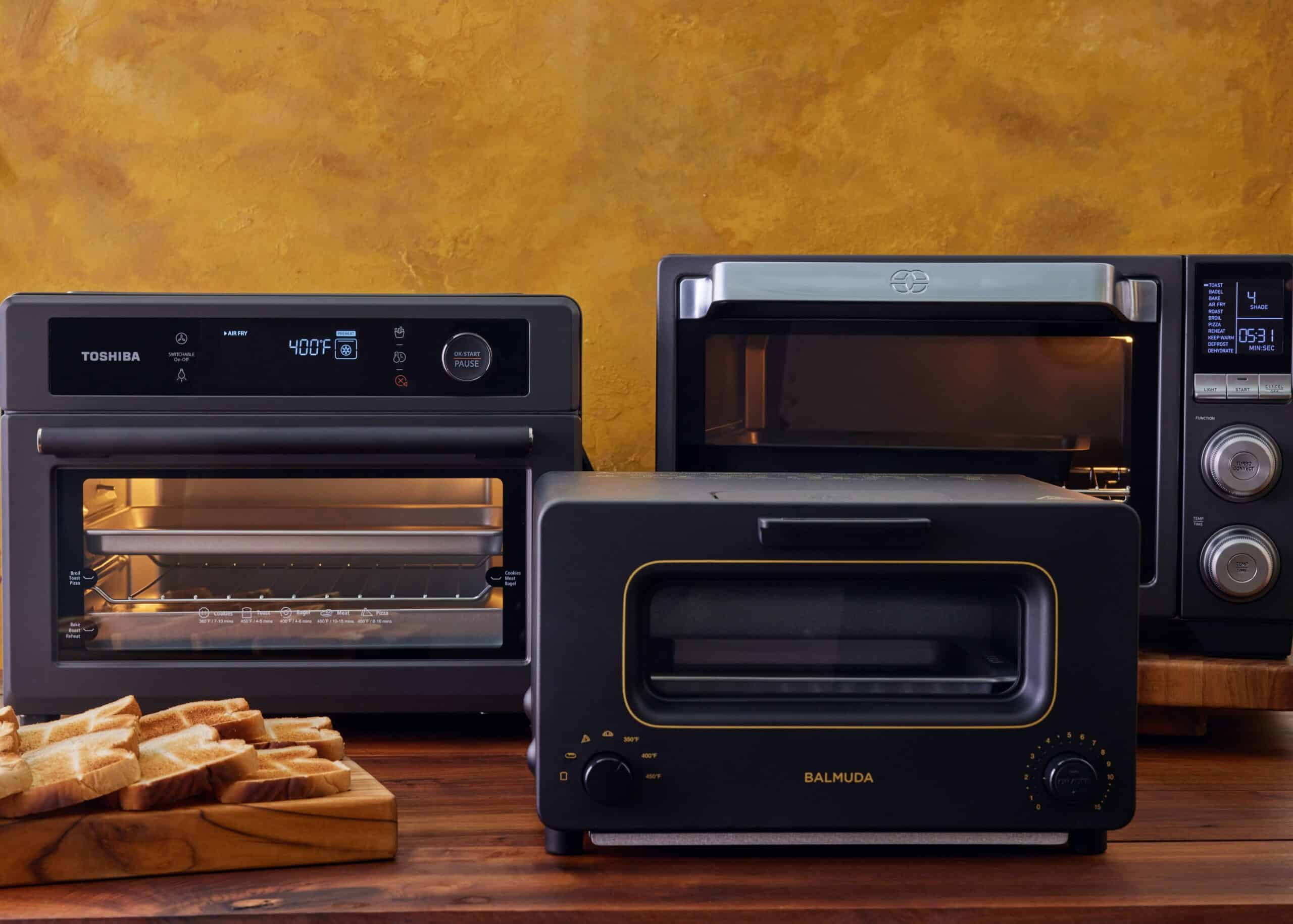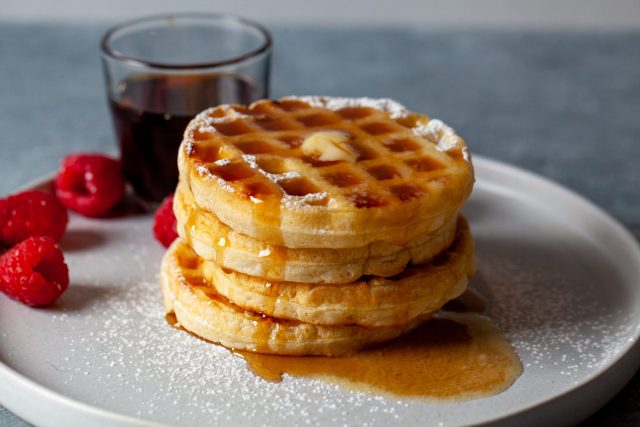Serious Eats / Ashlee Redger
Oil dispensers, sometimes called cruets, are one of the most undervalued pieces of kitchen equipment—take it from me, a reformed undervalue-er. For the last decade, I have used a bulbous glass oil dispenser that came to me secondhand. Sure, it leaked a little from the spout, was a chore to clean, and never quite got dry inside after it was washed…but it was better than pouring straight from the oil bottle (right?). I didn’t think twice about what I was missing: an oil dispenser that not only cleaned and poured better than mine but looked nicer, too.
To find the best oil dispensers, I tested 9 models made of glass, stainless steel, and ceramic. They held between 12 and 24 fluid ounces of oil and were priced between $13 and $50. Like Kenji found when he tested olive oil pour spouts, I discovered the best-performing models were also among the most affordable. The top two oil dispensers stood out because of their superior flow control, washability, and smart spout design. One of them has even found a permanent spot on my countertop, replacing my old go-to.
The Winners, at a Glance
The Best Overall Olive Oil Dispenser: OXO Precision Pour Glass Dispenser
This dispenser won me over from the first test since it was the only model never to drip or leak from the top. It poured in a thick stream as well as a precise drizzle (something nearly every other dispenser struggled to do). It was also the easiest dispenser to clean and dry.
The Best Tinted Olive Oil Dispenser: Zulay Glass Olive Oil Dispenser
Other than the OXO model, the dark brown Zulay was the only dispenser that allowed full control over the flow of oil, whether you poured a little or a lot. It was a more traditional style and came with two pour spouts: one with a hinge-top flap and one without. To compare with the other hinge-top models in the lineup, I tested this model with the hinge-less spout.
The Tests
Serious Eats / Ashlee RedgerPouring Test: I timed how quickly I could pour 1/2 cup of oil out of each dispenser. I noted how smoothly each one poured and if any leaked or dripped after stopping.Drizzling Test: I drizzled oil onto a plate using each dispenser to judge how accurate they were and to see if their spouts could maintain a thin, steady stream. I recorded any time oil glugged out of a dispenser, and when there was leaking or dripping.Durability Test: I placed each emptied dispenser on a towel-lined sheet pan and knocked them over three times to see if they could stand up to kitchen accidents.Cleaning Test: I hand-washed the dispensers after every test to evaluate how easy they were to clean. I also noted if a dispenser still had moisture in it after a day of air drying.
What We Learned
Tinted Dispensers Kept Oil Fresher
Serious Eats / Ashlee Redger
Oil dispensers are often made from semi-transparent tinted glass (like the dark glass Zulay Glass Olive Oil Dispenser) or stoneware (like the Emile Henry Oil Cruet). And this isn’t just to make the dispenser look good—it actually helps keep the oil fresher, too. There are two major reasons behind the chemical degradation (a.k.a. spoilage) of oil: hydrolytic rancidity and oxidative rancidity. Hydrolytic rancidity occurs when there is moisture in the oil, especially in the presence of enzymes. It is a good habit to make sure an oil cruet is clean and dry before filling it up (more on that later). Oxidative rancidity happens when oxygen in the air bonds with oil molecules, particularly in unsaturated varieties like olive and avocado oil. Ultraviolet light can speed up this reaction, so more opaque materials are ideal for mitigating light and slowing down degradation.
Although oxygen, light, and moisture are all factors in oil freshness, rancidity is still a relatively slow process. Even highly unsaturated oils like canola and sunflower can stay good for weeks (or months) once opened. Most everyday cooking oils that get used and refilled often will be just fine stored on the counter, even if they’re stored in transparent glass like that of our winning OXO Precision Pour Glass Dispenser. For delicate finishing oils (like pistachio oil) that may not be used as frequently, a more opaque cruet may be preferable to protect the nuanced flavors. Other precautions can also be taken, like only decanting a week’s worth of oil into the dispenser and keeping it away from bright areas in the kitchen. Heat encourages both hydrolytic and oxidative rancidity, so it’s also good practice to keep your oil dispenser away from the stove while cooking.
Spout Design Was Crucial
Spouts mattered when it came to steady, clean pours.Serious Eats / Ashlee Redger
For easy, controlled pouring and drip prevention, nothing mattered as much as the spout of the oil dispenser. Both the Emile Henry Oil Cruet and the Le Creuset Olive Oil Cruet had air intake tubes that were built into the spouts, which often clogged with oil, leading to glugging since the dispenser had to suck in air before it could continue pouring. The Le Creuset was especially susceptible to this since its air intake valve was set below the rim of the spout. During both the measuring and drizzling tests, it often poured in slow, uneven drips (even stopping at times) before an unexpected, thick stream of oil came out. Models with air intake holes (like the OXO) that were separate from the pour spouts allowed for continuous streams, as well as better control over the amount.
Many of the cruets also included hinged flip-top lids on their spouts, which were designed to keep dust and air out and flap open during use. I found these lids significantly contributed to dripping, though; they would get coated in oil while pouring, then deposit that oil onto the outside of the spout afterward. This can also make the base of the dispenser slippery as oil drips down the spout and onto the neck, as it did on the Crate and Barrel Oil Bottle. The truth is that the flip-top lids are not airtight, and the amount of airflow inside a dispenser between uses is minimal anyway. Drips can also make the spouts harder to clean over time, as the dried oil on the outside becomes sticky and attracts its own coating of dust and grime. I preferred spouts without the hinged lids as they had fewer drips and stayed cleaner. The OXO was the only dispenser to remain completely drip-free and pristine throughout every test. Its lidless spout had a folded lip that efficiently cut off the flow of oil, preventing any drips in the first place.
Wide-Mouth Openings Made Cleaning Easier
Wide-mouthed openings were easier to fill and clean.Serious Eats / Ashlee Redger
Unsurprisingly, oil dispensers with wider openings were easier to refill without spilling or needing a funnel. They were also simpler to clean—the OXO could be hand-washed with a kitchen sponge instead of a long bottle brush (although a reusable straw brush was still handy for scrubbing the spout). Another benefit of larger openings was better drying. Narrow bottlenecks prevented airflow inside, which caused moisture to condense inside the bottles instead of dripping out. This meant the cruets could take days to dry out fully or require clumsy interventions, like a rolled-up paper towel, to soak up the last bit of water and prevent the hydrolytic rancidity I explained earlier. The worst offenders were the ceramic models. After a day on the drying rack, I could still shake out drops of water from the Emile Henry Oil Cruet. With its truly opaque finish, I had no way of knowing when it was completely dried inside. The OXO, on the other hand, was dry within an hour of washing.
The Criteria: What to Look for in an Olive Oil Dispenser
Serious Eats / Ashlee Redger / Grace Kelly
A tinted glass or more opaque dispenser is better at preventing delicate oils from degradation, but transparent glass is okay for frequently used cooking oils. The lid should have an air intake hole that is separate from the pour spout. I liked spouts without a hinge-top flap because they minimized dripping and kept the bottles themselves cleaner. Wide-mouthed dispensers are easier to clean and refill. Plus, they dry quickly and thoroughly.
The Best Overall Olive Oil Dispenser: OXO Precision Pour Glass Dispenser
What we liked: While every other dispenser had drips of oil coating their spouts, the OXO stayed spotless throughout every test. It was easy to control the stream of oil, whether a thin drizzle or a full pour. This dispenser had a wide opening that made it effortless to clean, dry, and refill. The silicone insert in the lid pops in and out to wash, and every component is dishwasher-safe.
What we didn’t like: This dispenser can only hold one-and-a-half cups of oil at a time—the smallest capacity of any of the models tested.
Price at time of publish: $17.
Key Specs
Weight: 9 ouncesMaterials: Clear glass with a plastic, stainless steel, and silicone lidCapacity: 12 fluid ounces (1.5 cups)Height: 8 inchesWidth (at widest point): 2.5 inches Care: Dishwasher-safe (the silicone lid component comes out for better cleaning)
Serious Eats / Ashlee Redger
The Best Tinted Olive Oil Dispenser: Zulay Glass Olive Oil Dispenser
What we liked: The dark glass of the Zulay dispenser helps keep the oil inside fresher by letting in less light. Both spouts that were included with this dispenser had separate air intakes, which allowed for better control during each pour. It also came with a silicone cap for the hinge-less spout, as well as lids to seal the bottle completely, and a little funnel for refills.
What we didn’t like: Although there was less dripping on the hingeless spout compared to hinge-top models, a little oil still built up on the spout after each use. It also took the inside of this bottle longer to air dry after washing than the wide-mouthed OXO dispenser.
Price at time of publish: $20.
Key Specs
Weight: 14.1 ouncesMaterials: Dark brown glass with a stainless steel spoutCapacity: 17 fluid ounces (roughly 2 cups)Height: 12.5 inchesWidth (at widest point): 2.25 inches Care: Dishwasher-safeSerious Eats / Ashlee Redger
The Competition
Emile Henry Oil Cruet: This was a simple yet gorgeous dispenser—but the exposed cork stopper became saturated after a couple of uses, which contributed to oiliness around the neck of the bottle. The thin metal around the spout also felt flimsy and easily bent.Olipac Olino Olive Oil Dispenser: The stainless steel of the Olino was left smudged and slippery as oil dripped down the side after each pour, leaving a ring on the countertop. Olipac Elegante Olive Oil Dispenser: This was the only dispenser with no air intake, which led to heavy glugging and made the oil flow hard to control.Le Creuset Olive Oil Cruet: The model from Le Creuset was beautifully detailed, but the spout had both an internal air intake and a hinge-top flap. It made the oil flow hard to moderate and the bottle slippery, as oil dripped down the spout onto the stoneware base.Crate and Barrel Oil Bottle: Although it was similar to the Zulay dispenser, this bottle had more dripping due to the hinge-top flap on the spout.Rachel Ray Cucina Ceramics EVOO Bottle Dispenser: From the eccentric shape to the vibrant color, this model was a statement piece for the countertop. Unfortunately, its shape made it difficult to clean, plus it was awkward to hold and refill. BergHOFF Leo Glass Oil Dispenser: The instructions that came with this dispenser indicated you should hold the spout with your finger as you pour to prevent it from coming out, which was a red flag in the design for me (not to mention, super uncomfortable to do). It also leaked steadily out of the air intake, which caused oil to pool on top of the stopper.
FAQs
What is an oil cruet?
A cruet (read: dispenser) is a small container used to hold liquids such as vinegar or oil that are meant to be drizzled. It usually has some sort of pour spout for directing the liquid and is often made of opaque or dark glass or ceramic to keep its contents fresh.
What is the best material for an oil dispenser?
Great oil dispensers can be made out of a variety of materials, including glass, ceramic, or stainless steel. Transparent glass dispensers are best for everyday cooking oils that get used up quickly. Dispensers that are tinted or opaque can help keep more delicate oils (like extra-virgin olive oil) fresh longer.
What makes a good oil dispenser?
A good oil dispenser should have a spout that does not leak or drip down the side, which can make the base slippery at first, then grimy over time. To prevent the oil from glugging out as it pours, the topper should have a hole for air intake that is separate from the pour spout.
Can oil go rancid in an oil dispenser?
Yes. If left unused, oil can go rancid regardless of what it is stored in. Exposure to oxygen, heat, light, and moisture will speed up this process. To keep your oil as fresh as possible, only transfer what you can use within a week or two to your dispenser, then keep the rest in an airtight container in a cool, dark cabinet. Minimize exposure to heat by storing your countertop oil dispenser away from your stove.
How can you tell if oil is rancid?
The amount of time it takes for oil to go bad depends on what type of oil it is and its exposure to light, heat, air, and moisture. Oils that are high in unsaturated fats like canola oil will spoil faster than more saturated ones. Most cooking oils can last for two years unopened and several months once opened. Regardless of the type of oil, the best way to tell if it is good or not is to smell it: if you notice an “off” sour or stale smell, that can be a sign that the oil has spoiled. Rancid oil can also have a bitter, sour, or metallic taste.
What is the best way to clean an oil dispenser?
While many oil dispensers are dishwasher-safe, bottles with slim necks may not get fully cleaned that way. The most foolproof method to clean an oil dispenser is to use warm soapy water and a flexible bottle brush. You can also use a reusable straw brush to clean out smaller components, like the spout. Make sure to let your dispenser fully dry inside before refilling to prevent microbial growth and spoilage.


